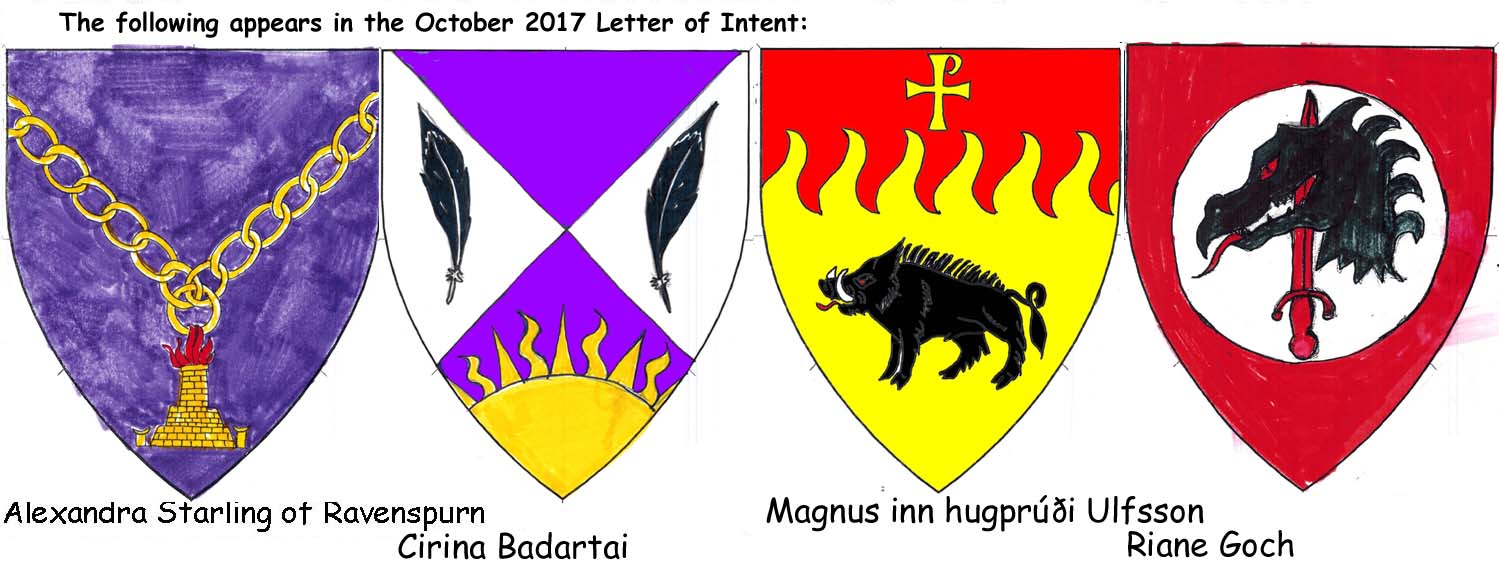
Kingdom of Atenveldt
Heraldic Submissions Page
(administered by the Brickbat Herald)
|
ATENVELDT COLLEGE OF HERALDS Letter of Intent 25 October 2016, A.S. LI
Unto Andrewe Laurel; Lillia Pelican; Brunissende Wreath; and the commenting Members of the College of Arms, Greetings from Marta as tu Mika-Mysliwy, Brickbat Herald and Parhelium Herald for the Kingdom of Atenveldt!
The Atenveldt College of Heralds requests the consideration and registration of the following names and armory with the College of Arms. Unless specifically stated, the client will accept any spelling and grammar corrections; all assistance is appreciated.
Alexandra
Starling of Ravenspurn:
DEVICE RESUBMISSION from Laurel, July 2016 The name was registered July 2016.
Cirina Badartai: NEW NAME CHANGE and NEW DEVICE Per saltire purpure and argent, in fess two feathers sable and a demi-sun issuant from base Or.
The name is Mongolian. Cirina is a female given name found in Mongolian Naming Practices, Marta as tu Mika-Mysliwy, http://heraldry.sca.org/names/mongolian_names_marta.html. Badartai means “monk, mdendicant.” The literal term is badarcila (http://www.linguamongolia.html) but following On the Documentation and Construction of Period Mongolian Names, Baras-aghur Naran (https://www.s-gabriel.org/names/baras-aghur/mongolian.html), it was suggested on Facebook's SCA Heraldry Chat that the appropriate suffix to indicate possessions (a conditiion of being a monk) would be “tai.” The client desires a female name and will not accept Major or Minor changes to the name. If registered, the client's current name, Serena the Lavendere, should be retained as an alternate name.
If the new device is registered, please retain the currently-registered one, Per pale purpure and argent, a butterfly counterchanged., as a badge.
Magnus inn hugprúði Ulfsson: NEW NAME and DEVICE Or, a boar statant sable and on a chief rayonny gules a tau-rho Or.
The name is Old Norse. Magnus is a masculine given name found in The Old Norse Name, Geir Bassi Haraldsson, p.13. Ulfr is a masculine given name, same source, p. 15. Ulfsson is an ON patronymic formed from Ulfr+son according to the patronymic formation p.17, in Geirr Bassi. To avoid a direct conflict with Magnus Ulfson, registered March 2016, the client has chosen the ON byname inn hugprúði, “stout-hearted,” found in “Viking Bynames found in the Landnámabók,” Aryanhwy merch Catmael (http://www.ellipsis.cx/~liana/names/norse/vikbynames.html), and so Magnus the stout-hearted, son of Ulfr.
The tau-rho staurogram is one of several christograms, or monogram-like devices used by ancient Christians, to refer to Jesus. However, New Testament scholar Larry Hurtado points out that the staurogram only refers to the crucifixion, unlike others, which mention Jesus’ other characteristics. Also, the staurogram is visual—the tau-rho combinations create images of Jesus on the cross, making the staurogram the earliest Christian images of Jesus on the cross. It is created out of the Greek letters tau and rho: “In Greek, the language of the early church, the capital tau, or T, looks pretty much like our T. The capital rho, or R, however, is written like our P. If you superimpose the two letters, it looks something like this.” (http://www.biblicalarchaeology.org/daily/biblical-topics/crucifixion/the-staurogram/)
Michael
Gerard Curtememoire comments further: The Bible History
Daily site--which looks to be itself a wholly reliable
source--lists and links to exactly one source at its parent site:
"The Staurogram: Earliest Depiction of Jesus' Crucifixion"
in the March/April 2013 issue of Biblical Archaeology Review,
showing the same papyrus. The body of that article is unfortunately
behind a membership wall, but a discussion without photographs by the
same author, arguing that the tau-rho cross or staurogram is earlier
than the 4th or 5th century based on the evidence of early papyri is
available at
https://www.era.lib.ed.ac.uk/bitstream/handle/1842/1204/staurogram%20chapter-%20Manuscripts%20volume
a.pdf;sequence=1. Since we know medieval scholars saw ancient
papryi, this is a small step toward the target Coblaith Muimnech
correctly sets, "a period form of a symbol used in the Middle
Ages or Renaissance". Many thanks to Michael for his exhaustive investigation!
Riane Goch: NEW DEVICE CHANGE Gules, on a plate a dragon's head erased sable impaled on a sword gules.
The name was registered December 2014.
If this is blazoned as an impaled head, there are only three layers to the design (field + plate + tertiary charge). If is is blazoned otherwise, there is a problem with excessive layering (Gules,on a plate a sword gules surmounted by a dragon's head erased sable.), with the dragon head becoming a quarternary charge. If the new device is registered, the current device, Per saltire argent and gules, in chief two chevronels couped and in base a pair of scissors sable., should be released.
There are 1 New Name, 1 New Name Change, 1 New Device, 2 New Device Changes. These 5 items are chargeable, Laurel should receive $20 for them. There is 1 Device Resubmission.. This is not chargeable. There are a total of 6 items submitted on this letter.
I was assisted in the preparation of this Letter of Intent by Commentary was provided by Coblaith Muimnech and Michael Gerard Curtememoire.
Thank you to those who have provided your wisdom and patience, your expertise and your willingness to share it.
Marta
as tu Mika-Mysliwy
|
This page is best viewed with a minimum of 800 x 600 resolution, and 16 million colors.

